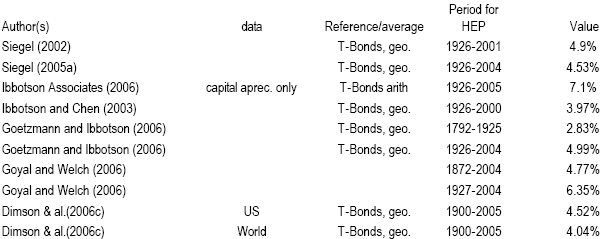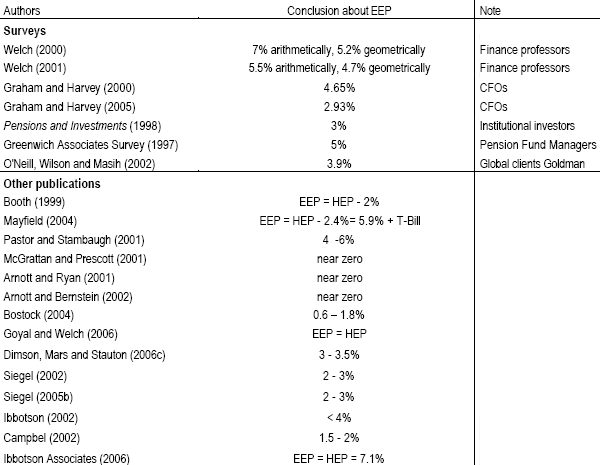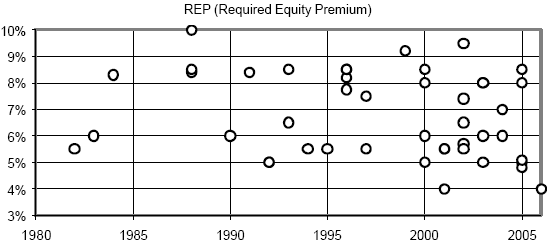What excess return have you gotten, do you expect, should you require, does the market imply for taking the risk of owning stocks? In his September 2006 paper entitled “Equity Premium: Historical, Expected, Required and Implied”, Pablo Fernandez addresses all these questions in a comprehensive overview/history and analysis of the equity risk premium in the U.S. and other countries. He begins with definitions of four perspectives on the equity premium, the first equal for all investors and the other three varying among investors:
- Historical equity premium (HEP) – the historical differential return of the stock market over treasury instruments.
- Expected equity premium (EEP) – the expected differential return of the stock market over treasury instruments.
- Required equity premium (REP) – the incremental return of a diversified portfolio (the market) over the risk-free rate (return of treasury instruments) required by an investor.
- Implied equity premium (IEP) – the equity premium that arises from assuming that the market price is correct.
He concludes that:
- Differences among HEP calculations are mainly due to the risk-free instrument and the stock indexes chosen.
- Over the past 25-45 years things (theory development, ascendancy of funds, electronic trading, regulation) changed. The relationship between interest rates and stock dividend/earnings yields has reversed.
- Standard asset pricing models fail to agree with HEP calculations (the equity premium puzzle) because the models are wrong and HEP is not predictive of future returns.
- Capital market data from before 1950 are not obviously useful for estimating future expected returns. In fact, HEP is generally not a good estimator for EEP.
- Assertion of specific values for EEP, REP and IEP for the overall stock market assume (unsupportably) that investors have homogeneous expectations and requirements.
- Since 1960, the difference between IEP and the expected dividend growth rate is proportional to the risk-free rate.
The following table, taken from the paper, lists long-term estimates for the historical equity premium (HEP) from various authors, generally using long-term Treasury bonds (T-Bonds) as the risk-free benchmark. It shows that most such estimates fall in the 4%-5% range.

The next table, also from the paper, lists estimates for expected equity premium (EEP) from various authors. Future expectations in aggregate tend to the low side of HEP. The first seven estimates are based on surveys of experts, and the rest on other methods.

The following chart, again from the paper, shows estimates for the required equity premium (REP) from various important financial textbooks according to year of publication. The data show fairly wide dispersion for any given year and suggest a slight downward trend.

In summary, the author provides a comprehensive overview of equity risk premium concepts and values, stressing the mid-20th century break in key financial relationships.